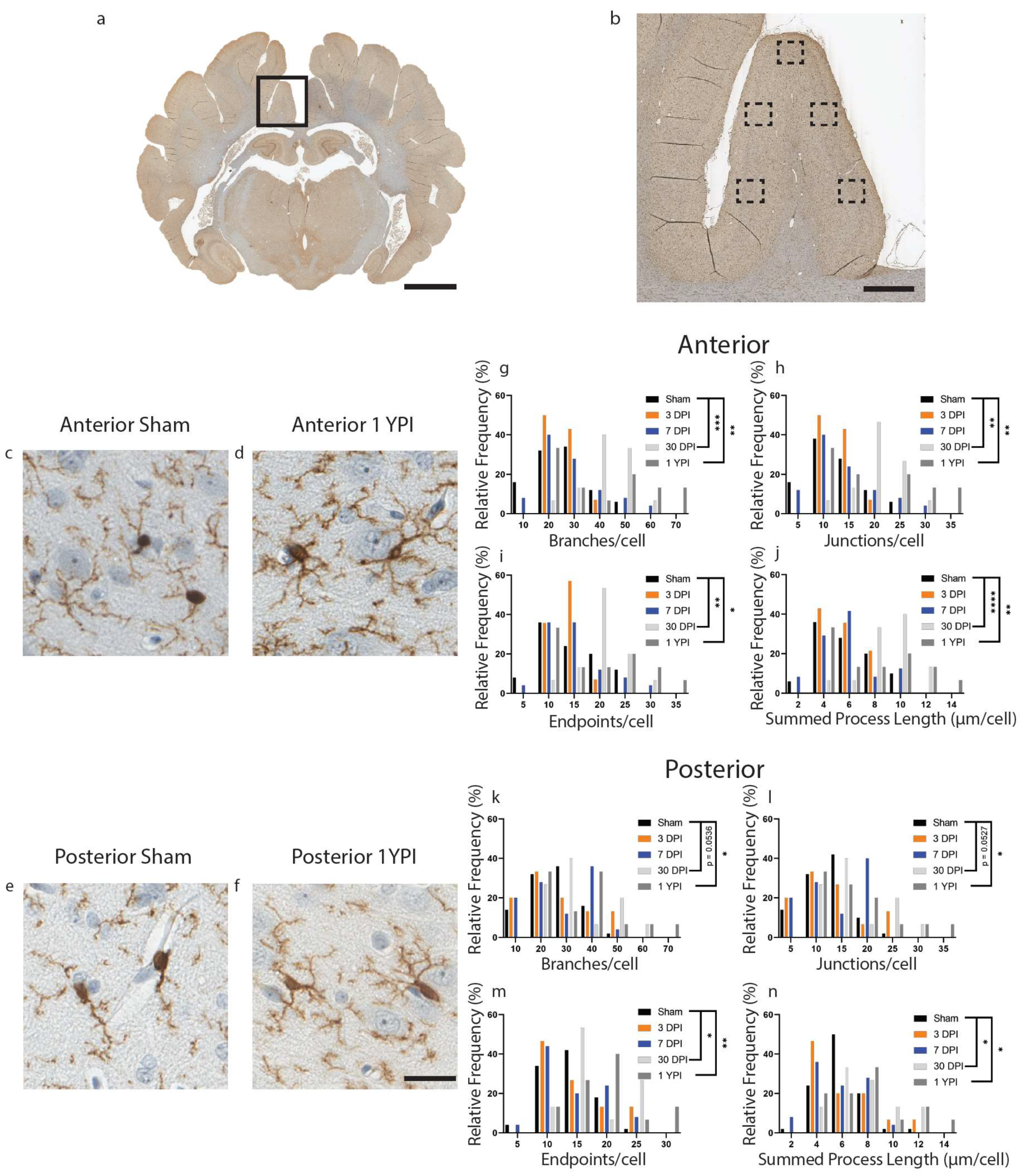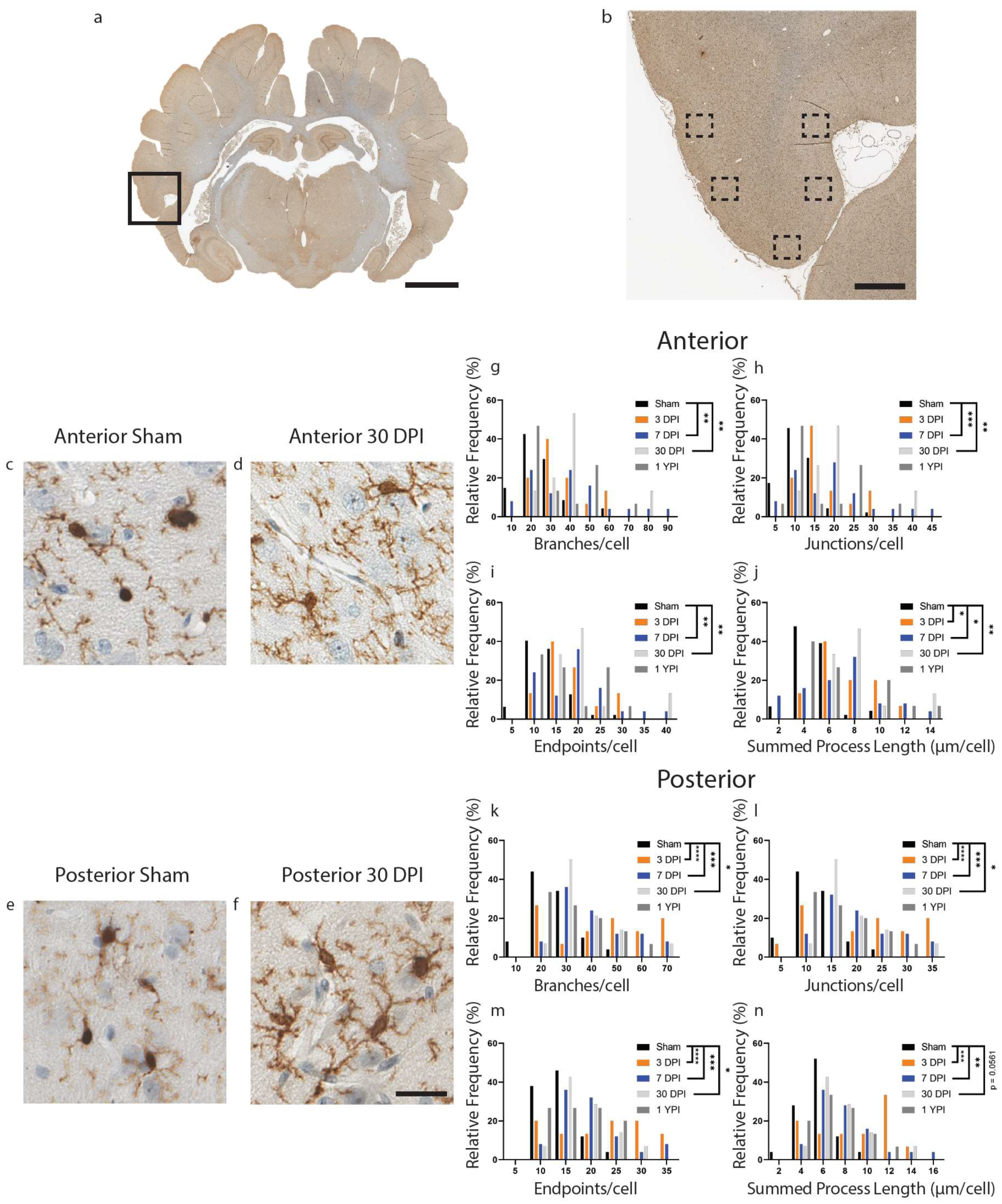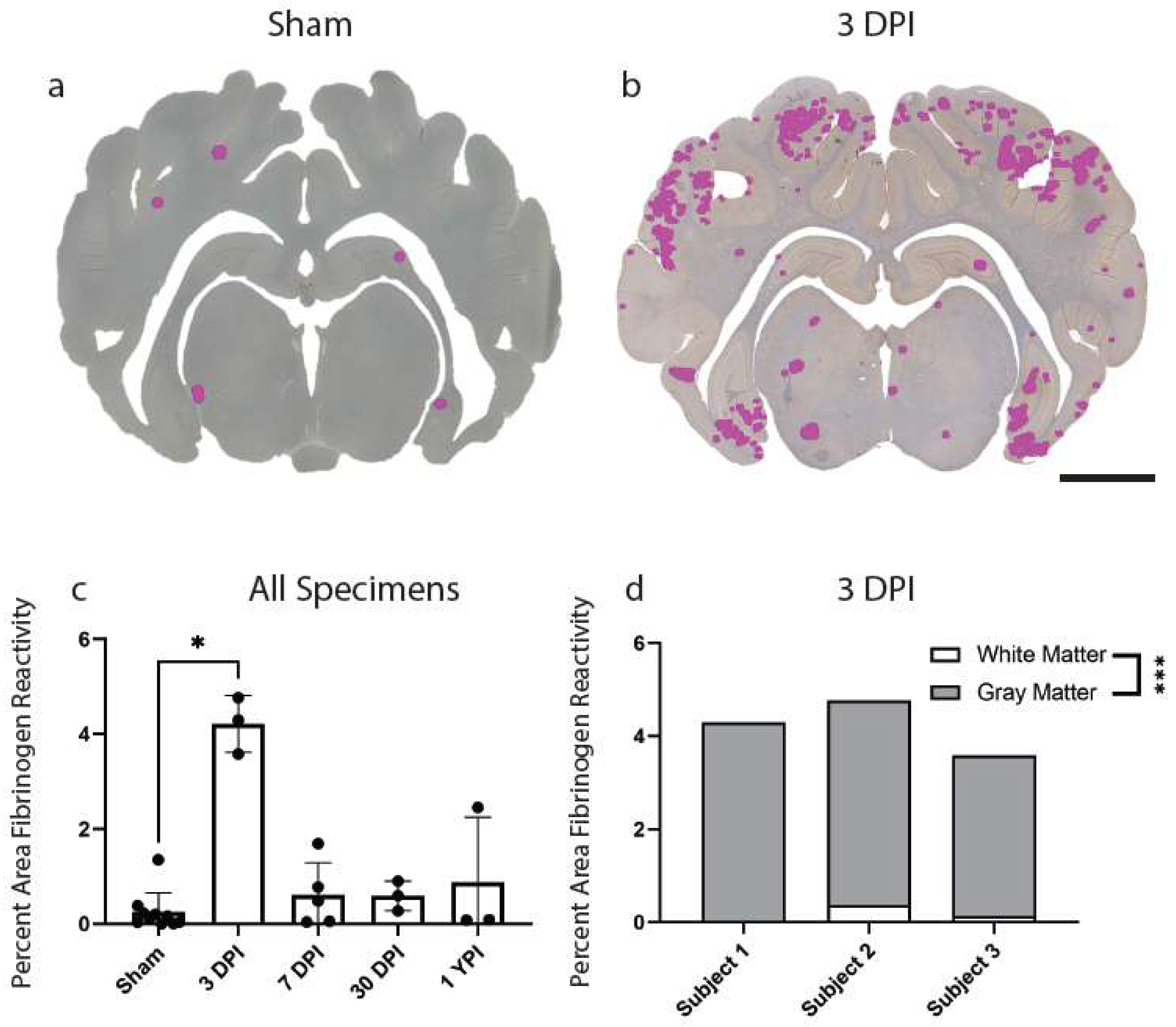Persistence of Hyper-Ramified Microglia in Porcine Cortical Gray Matter after Mild Traumatic Brain Injury
Abstract
:1. Introduction
2. Materials and Methods
2.1. Animal Subjects
2.2. Head Rotational TBI
2.3. Specimen Preparation
2.4. Immunohistochemical Staining and Microscopy
2.5. Neuropathological Analysis
2.6. Statistical Analysis
3. Results
3.1. Microglia Skeletal Analysis Revealed Chronic Changes in the Cingulate Gyrus
3.2. Microglia Skeletal Analysis Revealed Acute and Subacute Changes in the Inferior Temporal Gyrus
3.3. Total Cell Density and Neuron Density Did Not Change in the Cingulate Gyrus after Mild TBI
3.4. GFAP Reactivity Did Not Change after Single Mild TBI
3.5. Fibrinogen Reactivity Increased at 3 DPI after Mild TBI
4. Discussion
Author Contributions
Funding
Institutional Review Board Statement
Informed Consent Statement
Data Availability Statement
Acknowledgments
Conflicts of Interest
References
- Centers for Disease Control and Prevention. Surveillance Report of Traumatic Brain Injury-Related Emergency Department Visits, Hospitalizations, and Deaths-United States, 2014; Centers for Disease Control and Prevention (United States): Atlanta, GA, USA, 2019; Volume 24. [Google Scholar]
- Nguyen, R.; Fiest, K.M.; McChesney, J.; Kwon, C.-S.; Jette, N.; Frolkis, A.D.; Atta, C.; Mah, S.; Dhaliwal, H.; Reid, A.; et al. The international incidence of traumatic brain injury: A systematic review and meta-analysis. Can. J. Neurol. Sci. 2016, 43, 774–785. [Google Scholar] [CrossRef] [Green Version]
- Levin, H.S.; Diaz-Arrastia, R.R. Diagnosis, prognosis, and clinical management of mild traumatic brain injury. Lancet Neurol. 2015, 14, 506–517. [Google Scholar] [CrossRef]
- Cullen, D.K.; Harris, J.P.; Browne, K.D.; Wolf, J.A.; Duda, J.E.; Meaney, D.F.; Margulies, S.S.; Smith, D.H. A porcine model of traumatic brain injury via head rotational acceleration. Methods Mol. Biol. 2016, 1462, 289–324. [Google Scholar] [CrossRef] [Green Version]
- Chen, X.-H.; Meaney, D.; Xu, B.-N.; Nonaka, M.; McIntosh, T.K.; Wolf, J.A.; Saatman, K.E.; Smith, D.H. Evolution of Neurofilament Subtype Accumulation in Axons Following Diffuse Brain Injury in the Pig. J. Neuropathol. Exp. Neurol. 1999, 58, 588–596. [Google Scholar] [CrossRef] [PubMed]
- Smith, D.H.; Chen, X.-H.; Xu, B.-N.; McIntosh, T.K.; Gennarelli, T.A.; Meaney, D. Characterization of Diffuse Axonal Pathology and Selective Hippocampal Damage following Inertial Brain Trauma in the Pig. J. Neuropathol. Exp. Neurol. 1997, 56, 822–834. [Google Scholar] [CrossRef]
- Chen, X.-H.; Siman, R.; Iwata, A.; Meaney, D.F.; Trojanowski, J.Q.; Smith, D.H. Long-Term Accumulation of Amyloid-β, β-Secretase, Presenilin-1, and Caspase-3 in Damaged Axons Following Brain Trauma. Am. J. Pathol. 2004, 165, 357–371. [Google Scholar] [CrossRef] [PubMed]
- Cullen, D.K.; Harris, J.P.; Browne, K.D.; Wolf, J.A.; Duda, J.E.; Meaney, D.F.; Margulies, S.S.; Smith, D.H. Injury Models of the Central Nervous System. Methods Mol. Biol. 2016, 1462, 289–324. [Google Scholar] [CrossRef] [PubMed]
- Grovola, M.R.; Paleologos, N.; Brown, D.P.; Tran, N.; Wofford, K.L.; Harris, J.P.; Browne, K.D.; Shewokis, P.A.; Wolf, J.A.; Cullen, D.K.; et al. Diverse changes in microglia morphology and axonal pathology during the course of 1 year after mild traumatic brain injury in pigs. Brain Pathol. 2021, 31, e12953. [Google Scholar] [CrossRef] [PubMed]
- Johnson, V.E.; Stewart, W.; Smith, D.H. Axonal pathology in traumatic brain injury. Exp. Neurol. 2012, 246, 35–43. [Google Scholar] [CrossRef] [Green Version]
- Browne, K.D.; Chen, X.-H.; Meaney, D.F.; Smith, D.H. Mild Traumatic Brain Injury and Diffuse Axonal Injury in Swine. J. Neurotrauma 2011, 28, 1747–1755. [Google Scholar] [CrossRef] [Green Version]
- Song, J.; Li, J.; Chen, L.; Lu, X.; Zheng, S.; Yang, Y.; Cao, B.; Weng, Y.; Chen, Q.; Ding, J.; et al. Altered gray matter structural covariance networks at both acute and chronic stages of mild traumatic brain injury. Brain Imaging Behav. 2021, 15, 1840–1854. [Google Scholar] [CrossRef] [PubMed]
- Mayer, A.R.; Meier, T.B.; Dodd, A.B.; Stephenson, D.D.; Robertson-Benta, C.R.; Ling, J.M.; Reddy, S.P.; Zotev, V.; Vakamudi, K.; Campbell, R.A.; et al. Prospective Study of Gray Matter Atrophy Following Pediatric Mild Traumatic Brain Injury. Neurology 2023, 100, e516–e527. [Google Scholar] [CrossRef] [PubMed]
- Muller, A.M.; Panenka, W.J.; Lange, R.T.; Iverson, G.L.; Brubacher, J.R.; Virji-Babul, N. Longitudinal changes in brain parenchyma due to mild traumatic brain injury during the first year after injury. Brain Behav. 2021, 11, e2410. [Google Scholar] [CrossRef]
- LaPlaca, M.C.; Prado, G.R.; Cullen, D.K.; Simon, C.M. Plasma membrane damage as a marker of neuronal injury. Annu. Int. Conf. IEEE Eng. Med. Biol. Soc. 2009, 2009, 1113–1116. [Google Scholar] [CrossRef]
- Keating, C.E.; Cullen, D.K. Mechanosensation in traumatic brain injury. Neurobiol. Dis. 2020, 148, 105210. [Google Scholar] [CrossRef] [PubMed]
- Bartoletti, D.C.; Harrison, G.I.; Weaver, J.C. The number of molecules taken up by electroporated cells: Quantitative determination. FEBS Lett. 1989, 256, 4–10. [Google Scholar] [CrossRef] [Green Version]
- Farkas, O.; Lifshitz, J.; Povlishock, J.T. Mechanoporation induced by diffuse traumatic brain injury: An irreversible or reversible response to injury? J. Neurosci. 2006, 26, 3130–3140. [Google Scholar] [CrossRef] [Green Version]
- Singleton, R.H.; Povlishock, J.T. Identification and Characterization of Heterogeneous Neuronal Injury and Death in Regions of Diffuse Brain Injury: Evidence for Multiple Independent Injury Phenotypes. J. Neurosci. 2004, 24, 3543–3553. [Google Scholar] [CrossRef] [Green Version]
- Whalen, M.J.; Dalkara, T.; You, Z.; Qiu, J.; Bermpohl, D.; Mehta, N.; Suter, B.; Bhide, P.G.; Lo, E.H.; Ericsson, M.; et al. Acute Plasmalemma Permeability and Protracted Clearance of Injured Cells after Controlled Cortical Impact in Mice. J. Cereb. Blood Flow Metab. 2007, 28, 490–505. [Google Scholar] [CrossRef] [Green Version]
- Hernandez, M.L.; Chatlos, T.; Gorse, K.M.; Lafrenaye, A.D. Neuronal Membrane Disruption Occurs Late Following Diffuse Brain Trauma in Rats and Involves a Subpopulation of NeuN Negative Cortical Neurons. Front. Neurol. 2019, 10, 1238. [Google Scholar] [CrossRef] [Green Version]
- Cullen, D.K.; Vernekar, V.N.; LaPlaca, M.C.; Burda, J.E.; Bernstein, A.M.; Sofroniew, M.V.; Haslach, H.W.; Leahy, L.N.; Hsieh, A.H.; Maneshi, M.M.; et al. Trauma-Induced Plasmalemma Disruptions in Three-Dimensional Neural Cultures Are Dependent on Strain Modality and Rate. J. Neurotrauma 2011, 28, 2219–2233. [Google Scholar] [CrossRef] [PubMed] [Green Version]
- Wofford, K.L.; Harris, J.P.; Browne, K.D.; Brown, D.P.; Grovola, M.R.; Mietus, C.J.; Wolf, J.A.; Duda, J.E.; Putt, M.E.; Spiller, K.L.; et al. Rapid neuroinflammatory response localized to injured neurons after diffuse traumatic brain injury in swine. Exp. Neurol. 2017, 290, 85–94. [Google Scholar] [CrossRef] [Green Version]
- Grovola, M.R.; Paleologos, N.; Wofford, K.L.; Harris, J.P.; Browne, K.D.; Johnson, V.; Duda, J.E.; Wolf, J.A.; Cullen, D.K. Mossy cell hypertrophy and synaptic changes in the hilus following mild diffuse traumatic brain injury in pigs. J. Neuroinflamm. 2020, 17, 44. [Google Scholar] [CrossRef]
- Johnson, V.E.; Stewart, W.; Weber, M.T.; Cullen, D.K.; Siman, R.; Smith, D.H. SNTF immunostaining reveals previously undetected axonal pathology in traumatic brain injury. Acta Neuropathol. 2016, 131, 115–135. [Google Scholar] [CrossRef] [PubMed] [Green Version]
- Arganda-Carreras, I.; Fernández-González, R.; Muñoz-Barrutia, A.; Ortiz-De-Solorzano, C. 3D reconstruction of histological sections: Application to mammary gland tissue. Microsc. Res. Tech. 2010, 73, 1019–1029. [Google Scholar] [CrossRef] [PubMed]
- Schindelin, J.; Arganda-Carreras, I.; Frise, E.; Kaynig, V.; Longair, M.; Pietzsch, T.; Preibisch, S.; Rueden, C.; Saalfeld, S.; Schmid, B.; et al. Fiji: An open-source platform for biological-image analysis. Nat. Methods 2012, 9, 676–682. [Google Scholar] [CrossRef] [Green Version]
- García-Cabezas, M.; John, Y.J.; Barbas, H.; Zikopoulos, B. Distinction of Neurons, Glia and Endothelial Cells in the Cerebral Cortex: An Algorithm Based on Cytological Features. Front. Neuroanat. 2016, 10, 107. [Google Scholar] [CrossRef] [Green Version]
- Sofroniew, M.V.; Vinters, H.V. Astrocytes: Biology and pathology. Acta Neuropathol. 2010, 119, 7–35. [Google Scholar] [CrossRef] [Green Version]
- Harris, J.P.; Mietus, C.J.; Browne, K.D.; Wofford, K.L.; Keating, C.E.; Brown, D.P.; Johnson, B.N.; Wolf, J.A.; Smith, D.H.; Cohen, A.S.; et al. Neuronal Somatic Plasmalemmal Permeability and Dendritic Beading Caused By Head Rotational Traumatic Brain Injury in Pigs—An Exploratory Study. Front. Cell. Neurosci. 2023, 17, 1055455. [Google Scholar] [CrossRef]
- Johnson, V.E.; Weber, M.T.; Xiao, R.; Cullen, D.K.; Meaney, D.F.; Stewart, W.; Smith, D.H. Mechanical disruption of the blood–brain barrier following experimental concussion. Acta Neuropathol. 2018, 135, 711–726. [Google Scholar] [CrossRef] [Green Version]
- Hammond, T.R.; Dufort, C.; Dissing-Olesen, L.; Giera, S.; Young, A.; Wysoker, A.; Walker, A.J.; Gergits, F.; Segel, M.; Nemesh, J.; et al. Single-Cell RNA Sequencing of Microglia throughout the Mouse Lifespan and in the Injured Brain Reveals Complex Cell-State Changes. Immunity 2019, 50, 253–271.e6. [Google Scholar] [CrossRef] [PubMed] [Green Version]
- Saba, E.S.; Karout, M.; Nasrallah, L.; Kobeissy, F.; Darwish, H.; Khoury, S.J. Long-term cognitive deficits after traumatic brain injury associated with microglia activation. Clin. Immunol. 2021, 230, 108815. [Google Scholar] [CrossRef] [PubMed]
- Paolicelli, R.; Sierra, A.; Stevens, B.; Tremblay, M.E.; Aguzzi, A.; Ajami, B.; Amit, I.; Audinat, E.; Bechmann, I.; Bennett, M.; et al. Microglia states and nomenclature: A field at its crossroads. Neuron. 2022, 110, 3458–3483. [Google Scholar] [CrossRef] [PubMed]
- Grovola, M.R.; von Reyn, C.; Loane, D.J.; Cullen, D.K. Understanding microglial responses in large animal models of traumatic brain injury: An underutilized resource for preclinical and translational research. J. Neuroinflamm. 2023, 20, 67. [Google Scholar] [CrossRef] [PubMed]
- Salter, M.W.; Stevens, B. Microglia emerge as central players in brain disease. Nat. Med. 2017, 23, 1018–1027. [Google Scholar] [CrossRef]
- Morrison, H.; Young, K.; Qureshi, M.; Rowe, R.K.; Lifshitz, J. Quantitative microglia analyses reveal diverse morphologic responses in the rat cortex after diffuse brain injury. Sci. Rep. 2017, 7, 13211. [Google Scholar] [CrossRef] [PubMed] [Green Version]
- Smith, K.L.; Kassem, M.S.; Clarke, D.J.; Kuligowski, M.P.; Bedoya-Pérez, M.A.; Todd, S.M.; Lagopoulos, J.; Bennett, M.R.; Arnold, J.C. Microglial cell hyper-ramification and neuronal dendritic spine loss in the hippocampus and medial prefrontal cortex in a mouse model of PTSD. Brain Behav. Immun. 2019, 80, 889–899. [Google Scholar] [CrossRef]
- Hinwood, M.; Tynan, R.J.; Charnley, J.L.; Beynon, S.B.; Day, T.; Walker, F.R. Chronic Stress Induced Remodeling of the Prefrontal Cortex: Structural Re-Organization of Microglia and the Inhibitory Effect of Minocycline. Cereb. Cortex 2013, 23, 1784–1797. [Google Scholar] [CrossRef] [Green Version]
- Vidal-Itriago, A.; Radford, R.A.W.; Aramideh, J.A.; Maurel, C.; Scherer, N.M.; Don, E.K.; Lee, A.; Chung, R.S.; Graeber, M.B.; Morsch, M. Microglia morphophysiological diversity and its implications for the CNS. Front. Immunol. 2022, 13, 997786. [Google Scholar] [CrossRef]
- Petersen, M.A.; Ryu, J.K.; Akassoglou, K. Fibrinogen in neurological diseases: Mechanisms, imaging and therapeutics. Nat. Rev. Neurosci. 2018, 19, 283–301. [Google Scholar] [CrossRef]
- Szalay, G.; Martinecz, B.; Lénárt, N.; Környei, Z.; Orsolits, B.; Judák, L.; Császár, E.; Fekete, R.; West, B.L.; Katona, G.; et al. Microglia protect against brain injury and their selective elimination dysregulates neuronal network activity after stroke. Nat. Commun. 2016, 7, 11499. [Google Scholar] [CrossRef] [PubMed] [Green Version]
- Zhao, Z.; Nelson, A.R.; Betsholtz, C.; Zlokovic, B.V. Establishment and Dysfunction of the Blood-Brain Barrier. Cell 2015, 163, 1064–1078. [Google Scholar] [CrossRef] [PubMed] [Green Version]
- Burda, J.E.; Bernstein, A.M.; Sofroniew, M.V.; Angeles, L. Astrocyte roles in TBI. Exp. Neurol. 2016, 275, 305–315. [Google Scholar] [CrossRef] [Green Version]
- Hay, J.R.; Johnson, V.E.; Young, A.M.; Smith, D.H.; Stewart, W. Blood-Brain Barrier Disruption Is an Early Event That May Persist for Many Years After Traumatic Brain Injury in Humans. J. Neuropathol. Exp. Neurol. 2015, 74, 1147–1157. [Google Scholar] [CrossRef] [PubMed]
- Zhang, B.; Gaiteri, C.; Bodea, L.-G.; Wang, Z.; McElwee, J.; Podtelezhnikov, A.A.; Zhang, C.; Xie, T.; Tran, L.; Dobrin, R.; et al. Integrated Systems Approach Identifies Genetic Nodes and Networks in Late-Onset Alzheimer’s Disease. Cell 2013, 153, 707–720. [Google Scholar] [CrossRef] [PubMed] [Green Version]
- Liddelow, S.A.; Marsh, S.E.; Stevens, B. Microglia and Astrocytes in Disease: Dynamic Duo or Partners in Crime? Trends Immunol. 2020, 41, 820–835. [Google Scholar] [CrossRef] [PubMed]
- Wolf, J.A.; Johnson, B.N.; Johnson, V.E.; Putt, M.E.; Browne, K.D.; Mietus, C.J.; Brown, D.P.; Wofford, K.L.; Smith, U.H.; Grady, M.S.; et al. Concussion Induces Hippocampal Circuitry Disruption in Swine. J. Neurotrauma 2017, 34, 2303–2314. [Google Scholar] [CrossRef]





| Branches | Junctions | Endpoints | Summed Process Length | |
|---|---|---|---|---|
| Sham | 26.66 ± 10.03, 95% CI [23.81, 29.51] | 12.87 ± 5.09, 95% CI [11.42, 14.31] | 14.56 ± 5.36, 95% CI [13.03, 16.08] | 5.82 ± 2.07, 95% CI [5.23, 6.41] |
| 3 DPI | 26.51 ± 5.70, 95% CI [23.23, 29.80] | 12.73 ± 2.89, 95% CI [11.06, 14.40] | 14.11 ± 2.57, 95% CI [12.63, 15.60] | 5.75 ± 1.31, 95% CI [5.00, 6.51] |
| 7 DPI | 28.69 ± 12.15, 95% CI [23.68, 33.70] | 13.83 ± 6.19, 95% CI [11.27, 16.38] | 14.91 ± 5.37, 95% CI [12.69, 17.12] | 5.66 ± 2.00, 95% CI [4.81, 6.50] |
| 30 DPI | 40.77 ± 9.92, 95% CI [35.28, 46.27] | 20.00 ± 5.01, 95% CI [17.22, 22.78] | 20.33 ± 4.45, 95% CI [17.86, 22.79] | 8.91 ± 1.95, 95% CI [7.83, 9.99] |
| 1 YPI | 39.49 ± 18.73, 95% CI [29.12, 49.87] | 19.41 ± 9.53, 95% CI [14.13, 24.69] | 19.40 ± 8.15, 95% CI [14.89, 23.91] | 8.09 ± 3.56, 95% CI [6.12, 10.06] |
| Branches | Junctions | Endpoints | Summed Process Length | |
|---|---|---|---|---|
| Sham | 26.24 ± 8.18, 95% CI [23.92, 28.57] | 12.66 ± 4.10, 95% CI [11.49, 13.82] | 13.80 ± 3.79, 95% CI [12.72, 14.88] | 5.91 ± 1.75, 95% CI [5.41, 6.41] |
| 3 DPI | 26.81 ± 12.01, 95% CI [20.16, 33.46] | 12.99 ± 6.14, 95% CI [9.59, 16.39] | 13.95 ± 5.31, 95% CI [11.01, 16.88] | 5.96 ± 2.63, 95% CI [4.50, 7.42] |
| 7 DPI | 28.12 ± 11.28, 95% CI [23.46, 32.78] | 13.62 ± 5.78, 95% CI [11.23, 16.00] | 14.48 ± 4.98, 95% CI [12.42, 16.53] | 5.77 ± 2.12, 95% CI [4.89, 6.64] |
| 30 DPI | 34.88 ± 11.58, 95% CI [28.47, 41.30] | 17.05 ± 5.91, 95% CI [13.78, 20.33] | 17.73 ± 5.20, 95% CI [14.85, 20.61] | 7.75 ± 2.29, 95% CI [6.48, 9.02] |
| 1 YPI | 36.34 ± 14.42, 95% CI [28.35, 44.32] | 17.68 ± 7.31, 95% CI [13.63, 21.73] | 18.52 ± 6.44, 95% CI [14.95, 22.08] | 7.81 ± 2.84, 95% CI [6.24, 9.38] |
| Branches | Junctions | Endpoints | Summed Process Length | |
|---|---|---|---|---|
| Sham | 24.94 ± 10.59, 95% CI [21.84, 28.05] | 11.54 ± 4.60, 95% CI [10.18, 12.91] | 13.19 ± 4.66, 95% CI [11.82, 14.55] | 5.07 ± 1.68, 95% CI [4.58, 5.57] |
| 3 DPI | 35.52 ± 13.31, 95% CI [28.15, 42.89] | 17.30 ± 6.84, 95% CI [13.51, 21.09] | 17.98 ± 5.88, 95% CI [14.72, 21.23] | 7.34 ± 2.47, 95% CI [5.98, 8.71] |
| 7 DPI | 39.39 ± 19.18, 95% CI [31.48, 47.31] | 19.16 ± 9.70, 95% CI [15.16, 23.17] | 19.68 ± 8.44, 95% CI [16.19, 23.16] | 7.11 ± 3.17, 95% CI [5.81, 8.42] |
| 30 DPI | 40.99 ± 17.92, 95% CI [31.06, 50.91] | 20.04 ± 9.07, 95% CI [15.02, 25.06] | 20.55 ± 7.95, 95% CI [16.15, 24.95] | 8.01 ± 2.84, 95% CI [6.44, 9.59] |
| 1 YPI | 32.80 ± 17.00, 95% CI [23.38, 42.21] | 16.06 ± 8.70, 95% CI [11.24, 20.88] | 16.47 ± 7.40, 95% CI [12.38, 20.56] | 6.91 ± 3.31, 95% CI [5.08, 8.74] |
| Branches | Junctions | Endpoints | Summed Process Length | |
|---|---|---|---|---|
| Sham | 26.27 ± 8.09, 95% CI [23.97, 28.57] | 12.70 ± 4.11, 95% CI [11.53, 13.87] | 13.66 ± 3.63, 95% CI [12.63, 14.69] | 5.64 ± 1.64, 95% CI [5.18, 6.11] |
| 3 DPI | 44.78 ± 19.86, 95% CI [33.78, 55.78] | 21.93 ± 9.94, 95% CI [16.43, 27.44] | 22.21 ± 9.11, 95% CI [17.16, 27.25] | 8.91 ± 3.62, 95% CI [6.91, 10.91] |
| 7 DPI | 40.20 ± 14.75, 95% CI [34.11, 46.28] | 19.73 ± 7.35, 95% CI [16.69, 22.76] | 19.68 ± 6.57, 95% CI [16.97, 22.39] | 7.97 ± 2.92, 95% CI [6.76, 9.17] |
| 30 DPI | 37.48 ± 11.68, 95% CI [30.73, 44.22] | 18.35 ± 5.95, 95% CI [14.92, 21.79] | 18.57 ± 5.02, 95% CI [15.68, 21.47] | 7.63 ± 2.31, 95% CI [6.30, 8.96] |
| 1 YPI | 34.23 ± 12.09, 95% CI [27.53, 40.93] | 16.69 ± 6.18, 95% CI [13.27, 20.11] | 17.31 ± 5.24, 95% CI [14.40, 20.21] | 7.10 ± 2.26, 95% CI [5.85, 8.35] |
| 3 DPI | 7 DPI | 30 DPI | 1 YPI | |
|---|---|---|---|---|
| Total Cell Density | d = 1.13 | d = 1.35 | d = 0.51 | d = 1.28 |
Disclaimer/Publisher’s Note: The statements, opinions and data contained in all publications are solely those of the individual author(s) and contributor(s) and not of MDPI and/or the editor(s). MDPI and/or the editor(s) disclaim responsibility for any injury to people or property resulting from any ideas, methods, instructions or products referred to in the content. |
© 2023 by the authors. Licensee MDPI, Basel, Switzerland. This article is an open access article distributed under the terms and conditions of the Creative Commons Attribution (CC BY) license (https://creativecommons.org/licenses/by/4.0/).
Share and Cite
Grovola, M.R.; Jinich, A.; Paleologos, N.; Arroyo, E.J.; Browne, K.D.; Swanson, R.L.; Duda, J.E.; Cullen, D.K. Persistence of Hyper-Ramified Microglia in Porcine Cortical Gray Matter after Mild Traumatic Brain Injury. Biomedicines 2023, 11, 1960. https://doi.org/10.3390/biomedicines11071960
Grovola MR, Jinich A, Paleologos N, Arroyo EJ, Browne KD, Swanson RL, Duda JE, Cullen DK. Persistence of Hyper-Ramified Microglia in Porcine Cortical Gray Matter after Mild Traumatic Brain Injury. Biomedicines. 2023; 11(7):1960. https://doi.org/10.3390/biomedicines11071960
Chicago/Turabian StyleGrovola, Michael R., Alan Jinich, Nicholas Paleologos, Edgardo J. Arroyo, Kevin D. Browne, Randel L. Swanson, John E. Duda, and D. Kacy Cullen. 2023. "Persistence of Hyper-Ramified Microglia in Porcine Cortical Gray Matter after Mild Traumatic Brain Injury" Biomedicines 11, no. 7: 1960. https://doi.org/10.3390/biomedicines11071960
APA StyleGrovola, M. R., Jinich, A., Paleologos, N., Arroyo, E. J., Browne, K. D., Swanson, R. L., Duda, J. E., & Cullen, D. K. (2023). Persistence of Hyper-Ramified Microglia in Porcine Cortical Gray Matter after Mild Traumatic Brain Injury. Biomedicines, 11(7), 1960. https://doi.org/10.3390/biomedicines11071960







